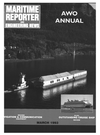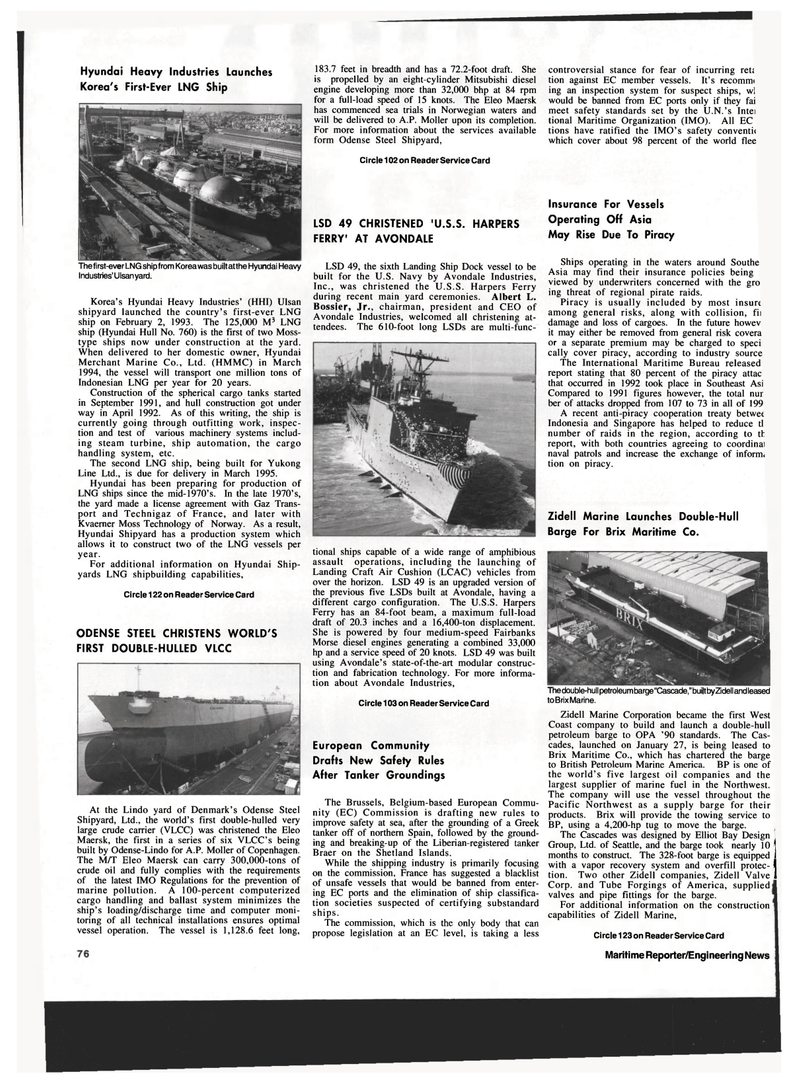
Page 74: of Maritime Reporter Magazine (March 1993)
Read this page in Pdf, Flash or Html5 edition of March 1993 Maritime Reporter Magazine
LSD 49 CHRISTENED 'U.S.S. HARPERS
FERRY' AT AVONDALE
Circle 102 on Reader Service Card
Hyundai Heavy Industries Launches
Korea's First-Ever LNG Ship 183.7 feet in breadth and has a 72.2-foot draft. She is propelled by an eight-cylinder Mitsubishi diesel engine developing more than 32,000 bhp at 84 rpm for a full-load speed of 15 knots. The Eleo Maersk has commenced sea trials in Norwegian waters and will be delivered to A.P. Moller upon its completion.
For more information about the services available form Odense Steel Shipyard,
The first-ever LNG shipfrom Korea was built atthe Hyundai Heavy
Industries'Ulsanyard.
Korea's Hyundai Heavy Industries' (HHI) Ulsan shipyard launched the country's first-ever LNG ship on February 2, 1993. The 125,000 M3 LNG ship (Hyundai Hull No. 760) is the first of two Moss- type ships now under construction at the yard.
When delivered to her domestic owner, Hyundai
Merchant Marine Co., Ltd. (HMMC) in March 1994, the vessel will transport one million tons of
Indonesian LNG per year for 20 years.
Construction of the spherical cargo tanks started in September 1991, and hull construction got under way in April 1992. As of this writing, the ship is currently going through outfitting work, inspec- tion and test of various machinery systems includ- ing steam turbine, ship automation, the cargo handling system, etc.
The second LNG ship, being built for Yukong
Line Ltd., is due for delivery in March 1995.
Hyundai has been preparing for production of
LNG ships since the mid-1970's. In the late 1970's, the yard made a license agreement with Gaz Trans- port and Technigaz of France, and later with
Kvaerner Moss Technology of Norway. As a result,
Hyundai Shipyard has a production system which allows it to construct two of the LNG vessels per year.
For additional information on Hyundai Ship- yards LNG shipbuilding capabilities,
Circle 122 on Reader Service Card
ODENSE STEEL CHRISTENS WORLD'S
FIRST DOUBLE-HULLED VLCC
LSD 49, the sixth Landing Ship Dock vessel to be built for the U.S. Navy by Avondale Industries,
Inc., was christened the U.S.S. Harpers Ferry during recent main yard ceremonies. Albert L.
Bossier, Jr., chairman, president and CEO of
Avondale Industries, welcomed all christening at- tendees. The 610-foot long LSDs are multi-func- tional ships capable of a wide range of amphibious assault operations, including the launching of
Landing Craft Air Cushion (LCAC) vehicles from over the horizon. LSD 49 is an upgraded version of the previous five LSDs built at Avondale, having a different cargo configuration. The U.S.S. Harpers
Ferry has an 84-foot beam, a maximum full-load draft of 20.3 inches and a 16,400-ton displacement.
She is powered by four medium-speed Fairbanks
Morse diesel engines generating a combined 33,000 hp and a service speed of 20 knots. LSD 49 was built using Avondale's state-of-the-art modular construc- tion and fabrication technology. For more informa- tion about Avondale Industries,
Circle 103 on Reader Service Card
European Community
Drafts New Safety Rules
After Tanker Groundings
At the Lindo yard of Denmark's Odense Steel
Shipyard, Ltd., the world's first double-hulled very large crude carrier (VLCC) was christened the Eleo
Maersk, the first in a series of six VLCC's being built by Odense-Lindo for A.P. Moller of Copenhagen.
The M/T Eleo Maersk can carry 300,000-tons of crude oil and fully complies with the requirements of the latest IMO Regulations for the prevention of marine pollution. A 100-percent computerized cargo handling and ballast system minimizes the ship's loading/discharge time and computer moni- toring of all technical installations ensures optimal vessel operation. The vessel is 1,128.6 feet long,
The Brussels, Belgium-based European Commu- nity (EC) Commission is drafting new rules to improve safety at sea, after the grounding of a Greek tanker off of northern Spain, followed by the ground- ing and breaking-up of the Liberian-registered tanker
Braer on the Shetland Islands.
While the shipping industry is primarily focusing on the commission, France has suggested a blacklist of unsafe vessels that would be banned from enter- ing EC ports and the elimination of ship classifica- tion societies suspected of certifying substandard ships.
The commission, which is the only body that can propose legislation at an EC level, is taking a less controversial stance for fear of incurring ret; tion against EC member vessels. It's recommi ing an inspection system for suspect ships, wl would be banned from EC ports only if they fai meet safety standards set by the U.N.'s Intei tional Maritime Organization (IMO). All EC tions have ratified the IMO's safety conventii which cover about 98 percent of the world flee
Insurance For Vessels
Operating Off Asia
May Rise Due To Piracy
Ships operating in the waters around Southe
Asia may find their insurance policies being viewed by underwriters concerned with the gro ing threat of regional pirate raids.
Piracy is usually included by most insure among general risks, along with collision, fii damage and loss of cargoes. In the future howev it may either be removed from general risk covera or a separate premium may be charged to speci cally cover piracy, according to industry source
The International Maritime Bureau released report stating that 80 percent of the piracy attac that occurred in 1992 took place in Southeast Asi
Compared to 1991 figures however, the total nur ber of attacks dropped from 107 to 73 in all of 199
A recent anti-piracy cooperation treaty betwee
Indonesia and Singapore has helped to reduce tl number of raids in the region, according to tl report, with both countries agreeing to coordinal naval patrols and increase the exchange of inform, tion on piracy.
Zidell Marine Launches Double-Hull
Barge For Brix Maritime Co.
The double-hull petroleumbarge "Cascade,"built by Zidellandleased to Brix Marine.
Zidell Marine Corporation became the first West
Coast company to build and launch a double-hull petroleum barge to OPA '90 standards. The Cas- cades, launched on January 27, is being leased to
Brix Maritime Co., which has chartered the barge to British Petroleum Marine America. BP is one of the world's five largest oil companies and the largest supplier of marine fuel in the Northwest.
The company will use the vessel throughout the
Pacific Northwest as a supply barge for their products. Brix will provide the towing service to
BP, using a 4,200-hp tug to move the barge.
The Cascades was designed by Elliot Bay Design
Group, Ltd. of Seattle, and the barge took nearly 10 ] months to construct. The 328-foot barge is equipped I with a vapor recovery system and overfill protec- | tion. Two other Zidell companies, Zidell Valve i
Corp. and Tube Forgings of America, supplied valves and pipe fittings for the barge.
For additional information on the construction capabilities of Zidell Marine,
Circle 123 on Reader Service Card 100 Maritime Reporter/Engineering News

 73
73

 75
75
